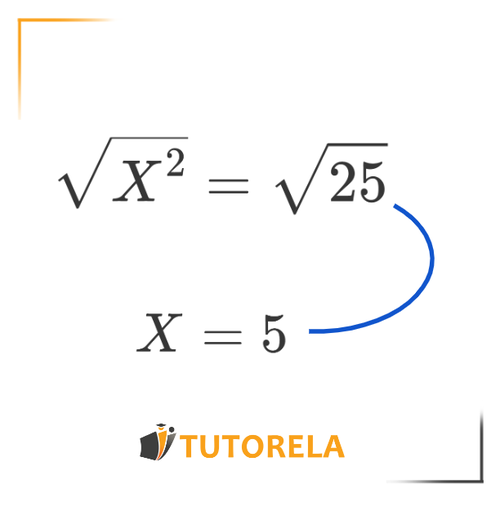What are those mysterious square roots that often confuse students and complicate their lives? The truth is that to understand them, we need to grasp the concept of the inverse operation.
What is a square root?
What is a square root?
When we solve an exercise like , it's clear that times (that is, multiplying the number by itself) results in . This is the concept of a power, or to be more precise, a square power, which to apply, we must multiply the figure or the number by itself.
The concept of "square root" refers to the inverse operation of squaring numbers.
That is, if we have and we want to find the value of , what we need to do is perform an identical operation on both sides of the equation.

This operation is the square root.
So, we have: and the result is .
Test yourself on square roots!
\( \sqrt{36}= \)
Now let's explain in more detail the operation we have performed.
- On the left side of the equation, the square root cancels out the squared power (the square root and the squared power are inverse operations, remember?).
- On the right side, we look for the figure or number that, when squared, gives us the result .
There are two numbers that meet these requirements: and .
With that said, it's important to remember that the square root of a number will always be positive.
Therefore, to summarize, in the exercise: for example, we have two possible answers: and .
If we are given the mathematical expression the only possible answer will be .
Finding the Square Root Conditions
- The only condition that must be met to find a square root is that the number under the square root must be positive.
You cannot find the square root of a negative number, that is, the expression is not correct and has no answer.
On the other hand,
- the result of a square root does not necessarily have to be an integer,
that is, as long as the number under the square root is positive, we can find its square root.
For example:
\( \sqrt{64}= \)
\( \sqrt{100}= \)
\( \sqrt{64}= \)
Simple Square Root Calculation
Simple square roots are based on multiplication tables. Let's see some examples:
Example No. 1
Solution: The square root, as we have already seen, is the inverse operation of squaring a number. Therefore, we must ask ourselves which number squared, or which number multiplied by itself, will result in .
Given that:
the answer will be:
\( \sqrt{25}= \)
\( \sqrt{81}= \)
\( \sqrt{16}= \)
Example No. 2
Solution: in this case, we also have to ask ourselves what number squared, or what number multiplied by itself, results in .
Given that: the answer will be:
Example No. 3
Solution: following the same logic, we see that and, therefore, the answer will be: .
\( \sqrt{9}= \)
\( \sqrt{4}= \)
\( \sqrt{49}= \)
Mathematical Operations and Square Roots
In this section, we will apply what we have learned so far regarding square roots and see how we can use this information to solve algebraic exercises that include square roots.
An important rule that we must remember when solving these types of exercises is that:
Square roots should be solved first, that is, before any other mathematical operation that is outside of the square root itself.
Exercises with Solutions
Exercise No. 1
Solution:
First, we will solve the square root, as it comes before the addition that is outside of it.
Thus, we obtain:
Then we continue with the rest of the exercise:
Therefore, the result is
\( \sqrt{36}= \)
\( \sqrt{441}= \)
Choose the largest value
Exercise No. 2
Solution:
This exercise is a bit more complicated. Initially, we must solve the square root, as this operation precedes any other in the exercise.
Thus, we obtain:
Afterwards, we should approach the exercise like any other math problem: .
According to the order of operations in math, multiplication and division come before addition and subtraction. Therefore, the result is: .
The answer to the exercise is:
Exercise No. 3
Solution:
Here we also need to solve the square roots first.
We insert the numbers and solve according to the order of operations:
Therefore, the answer is:
Examples and Exercises with Solutions for Square Roots
Exercise #1
Video Solution
Step-by-Step Solution
Let's solve the problem step by step:
- Step 1: Understand what the square root means.
- Step 2: Apply this definition to the number .
- Step 3: Determine the correct number.
The square root of a number is a value that, when multiplied by itself, equals . This is written as .
We are looking for a number such that . This translates to finding .
We know that . Therefore, the principal square root of is .
Thus, the solution to the problem is .
Among the given choices, the correct one is: Choice 1: .
Answer
6
Exercise #2
Video Solution
Step-by-Step Solution
To solve this problem, we'll follow these steps:
- Step 1: Recognize what finding a square root means
- Step 2: List known perfect squares to identify which one results in 64
- Step 3: Verify the square root by calculation
Now, let's work through each step:
Step 1: To find the square root of 64, we seek a number that, when multiplied by itself, equals 64.
Step 2: Consider the sequence of perfect squares: , , , , , , , .
Step 3: We see that . Therefore, the square root of 64 is 8.
Therefore, the solution to this problem is .
Answer
8
Exercise #3
Video Solution
Step-by-Step Solution
The task is to find the square root of the number 100. The square root operation seeks a number which, when squared, equals the original number. For any positive integer, if , then should be our answer.
Step 1: Recognize that 100 is a perfect square. This means there exists an integer such that . Generally, we recall basic squares such as:
- and so forth, up to
Step 2: Checking integers, we find that:
Step 3: Confirm the result: Since , then .
Step 4: Compare with answer choices. Given that one of the choices is 10, and , choice 1 is correct.
Therefore, the square root of 100 is 10.
Answer
10
Exercise #4
Video Solution
Step-by-Step Solution
To solve this problem, we'll determine the square root of 64, following these steps:
- Step 1: Identify the number whose square root we need to find. The number given is 64.
- Step 2: Determine which number, when multiplied by itself, equals 64.
- Step 3: Recall that .
Now, let's work through each step:
Step 1: We are tasked with finding . The problem involves identifying the number which, when squared, results in 64.
Step 2: To find this number, we'll check our knowledge of squares. We know that 8 is a significant integer whose square results in 64.
Step 3: Compute: . Hence, meets the requirement.
We find that the solution to the problem is .
Answer
8
Exercise #5
Video Solution
Step-by-Step Solution
To solve this problem, we need to determine the square root of 25.
- Step 1: The square root operation asks us to find a number that, when multiplied by itself, equals the given number, 25.
- Step 2: Consider what number times itself equals 25. We note that .
- Step 3: Thus, the square root of 25 is 5.
Therefore, the solution to the problem is .
The correct answer is choice 2: 5.
Answer
5
Solve the following exercise:
\( \sqrt{x^2}= \)
\( \sqrt{144}= \)
\( \sqrt{36}= \)
- Order of Operations: Exponents
- Order of Operations: Roots
- Division and Fraction Bars (Vinculum)
- The Numbers 0 and 1 in Operations
- Neutral Element (Identity Element)
- Order or Hierarchy of Operations with Fractions
- Exponential Equations
- Multiplicative Inverse
- Integer powering
- Exponents and Roots - Basic
- Exponents and Exponent rules
- Exponents - Special Cases
- Negative Exponents
- Zero Exponent Rule
- Basis of a power
- The exponent of a power
- Power of a Quotient
- Exponent of a Multiplication
- Multiplying Exponents with the Same Base
- Division of Exponents with the Same Base
- Power of a Power
- Powers
- Order of Operations - Exponents and Roots
- Special cases (0 and 1, reciprocals, fraction line)









